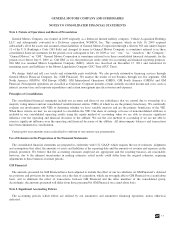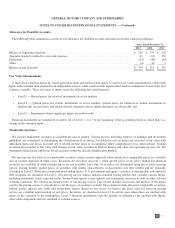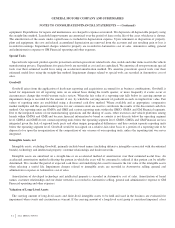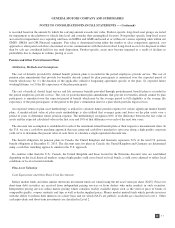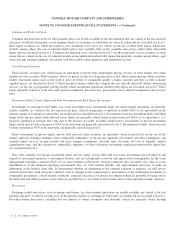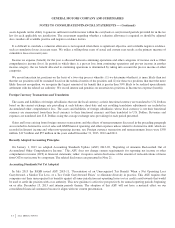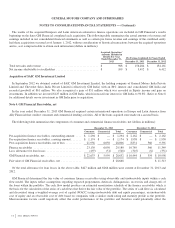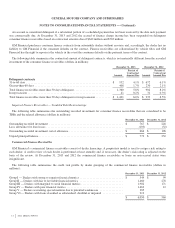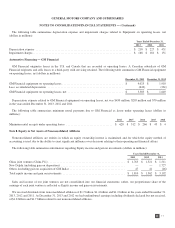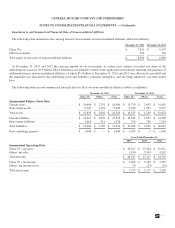General Motors 2013 Annual Report Download - page 69
Download and view the complete annual report
Please find page 69 of the 2013 General Motors annual report below. You can navigate through the pages in the report by either clicking on the pages listed below, or by using the keyword search tool below to find specific information within the annual report.
GENERAL MOTORS COMPANY AND SUBSIDIARIES
NOTES TO CONSOLIDATED FINANCIAL STATEMENTS — (Continued)
independent pricing services with observable inputs are generally classified in Level 2. Swaps that are cleared by clearinghouses or
exchanges are valued with the prices provided by those venues and are generally classified in Level 2. Derivatives classified in
Level 3 are typically valued via the use of pricing models which incorporate significant unobservable inputs, but may also include
derivatives which are valued with the use of significant observable inputs which are not subject to corroboration. The inputs part of
the model based valuations may include extrapolated or model-derived assumptions such as volatilities, yield and credit spread
assumptions.
Due to the lack of timely available market information for certain investments in the asset classes described above as well as the
inherent uncertainty of valuation, reported fair values may differ from fair values that would have been used had timely available
market information been available.
Job Security Programs and Extended Disability Benefits
We have job security programs to provide International Union, United Automobile, Aerospace and Agriculture Implement Workers
of America (UAW) and Canadian Auto Workers Union (CAW) employees reduced wages and continued coverage under certain
employee benefit programs depending on the employee’s classification as well as the number of years of service that the employee
has accrued. We also provide extended disability benefits for employees currently disabled and those in the active workforce who may
become disabled in the form of income replacement, healthcare costs and life insurance premiums.
We recognize a liability for job security programs and extended disability benefits over the expected service period using
measurement provisions similar to those used to measure our other postretirement benefits (OPEB) obligations based on our best
estimate of the probable liability at the measurement date. We record actuarial gains and losses immediately in earnings.
Stock Incentive Plans
We measure and record compensation expense for all share-based payment awards based on the award’s estimated fair value which
is the fair value of our common stock on the date of grant, or for restricted stock units (RSUs) granted prior to our public offering, the
fair value of our common stock as of the date of the public offering. We record compensation cost for the awards on a straight-line
basis over the entire vesting period, or for retirement eligible employees over the requisite service period. Salary stock awards granted
are fully vested and nonforfeitable upon grant; therefore, compensation cost is recorded on the date of grant. The liability for stock
incentive plan awards settled in cash is remeasured to fair value at the end of each reporting period.
Policy, Product Warranty and Recall Campaigns
The estimated costs related to policy and product warranties are accrued at the time products are sold and are charged to
Automotive cost of sales. These estimates are established using historical information on the nature, frequency and average cost of
claims of each vehicle line or each model year of the vehicle line and assumptions about future activity and events. Revisions are
made when necessary based on changes in these factors. Trends of claims are actively studied and actions are taken to improve
vehicle quality and minimize claims. The estimated costs related to product recalls based on a formal campaign soliciting return of
that product are accrued when they are deemed to be probable and can be reasonably estimated.
Income Taxes
The liability method is used in accounting for income taxes. Deferred tax assets and liabilities are recorded for temporary
differences between the tax basis of assets and liabilities and their reported amounts in the consolidated financial statements using the
statutory tax rates in effect for the year in which the differences are expected to reverse. The effect on deferred tax assets and
liabilities of a change in tax rates is recorded in the results of operations in the period that includes the enactment date under the law.
Deferred income tax assets are evaluated quarterly to determine if valuation allowances are required or should be adjusted. We
establish valuation allowances for deferred tax assets based on a more likely than not standard. The ability to realize deferred tax
67




